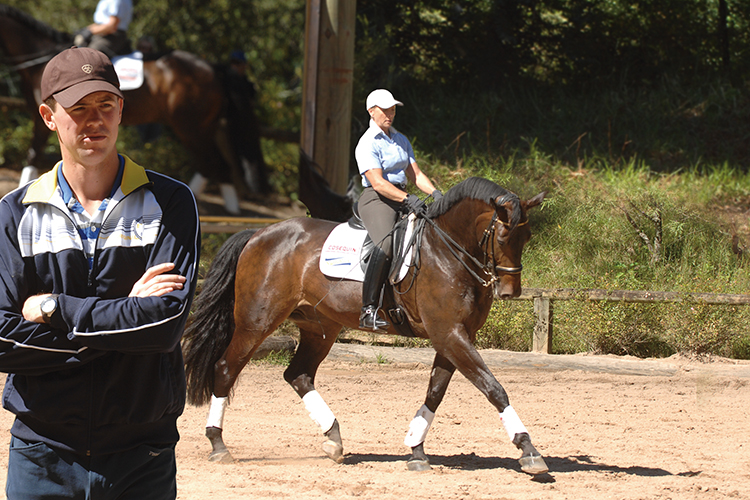 One of the many intriguing things about the equestrian art is that it is both simple, and complex, at the same time. Good training is really quite simple, but it only works when applied with great discipline, tact and subtlety – which is why real dressage instructors sometimes sound like Buddhist monks who specialise in riddles like ‘listen to the sound of one handed clapping’.
One of the many intriguing things about the equestrian art is that it is both simple, and complex, at the same time. Good training is really quite simple, but it only works when applied with great discipline, tact and subtlety – which is why real dressage instructors sometimes sound like Buddhist monks who specialise in riddles like ‘listen to the sound of one handed clapping’.
In Stefan Wolff’s case the real bonus is that Stefan is primarily a rider. After several years working as Bereiter for Klaus Balkenhol, Stefan is now based in a new barn in the United States, where once again, his main job is riding horses – teaching students is a bonus. It is a tribute to the thoroughness of the German system, and to Stefan’s intelligence, that even working in a second language he is such a subtle and effective teacher.
When I caught up with him last, Stefan was on his third visit to Clemens and Judy Dierks’ training stables in Arcadia, in the heart of Sydney’s dressage belt. It meant that Stefan had been working over a period of time with Judy and her then FEI front-liner, HP Frontier.
It’s so nice when ducklings turn into swans, and it must be confessed that as a youngster, Frontier was a bit of a gawky duck – a goose even – so how nice is it that with the correct work and training, he is now emerging swan-like, as one of the most exciting young Grand Prix horses in Australia, and at the age of just eight, he has the Special Championship from the most recent CDI to prove it.
So this horse is the result of team work, the Dierks team, Clemens and Judy have produced a series of Grand Prix horses, but this time there is a little added something in the mix, the regular visits to the Dierks Training stables of Stefan Wolff.
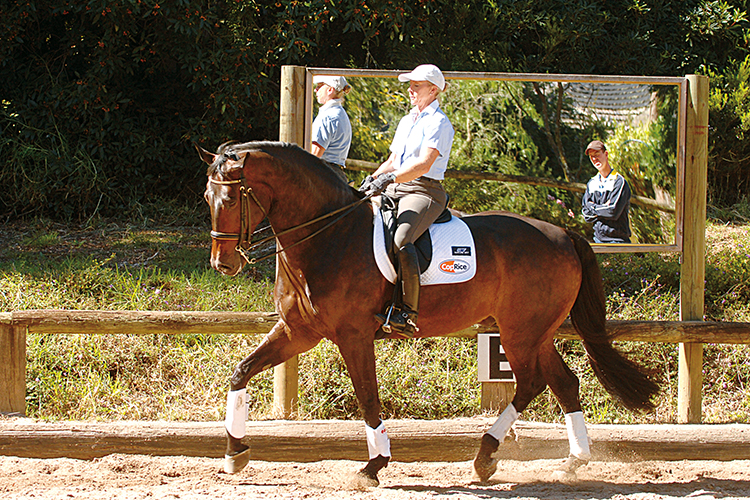
Like his mentor, Klaus Balkenhol, Stefan is absolutely determined that the horse is thoroughly relaxed and through before the work can begin.
“Give, then work him from behind. Don’t hold him down, keep it light, then remind him to work from behind through his body – the neck is only transferring it to the hand. Lighten Judy, there, only now can you start.”
And start they do, the gelding has acquired a new dimension of power and athleticism since last I saw him. When he is thoroughly worked in, Stefan decides to check the progress since their last meeting…
“Now go to passage but keep him working low with a very light rein…”
But the minute Judy tries to take this softness and throughness to the passage, Frontier loses it: “He is up in the neck and blocking the body – your hand is only influencing the neck and not the movement. Go to walk, walk, passage, walk, get his neck out again. Now go out in trot, he is light and from behind again. Back to passage, but keep his body involved, don’t let him suck back. He needs to be more oriented forward, no matter how much you bring him back.”
That’s the first of Stefan’s mind-bogglers. “We want the horse more forward, no matter how much we bring him back…” Solve that and you hear the that one hand clapping.
But it does make sense, and Stefan emphasises the point: “When you feel the contact is fragile, don’t make the mistake of taking with the hand – close from behind. It’s not about pulling him up, it’s about keeping the neck low, and getting him to use the right muscles. Get him lower in the neck so you can have him more uphill.”
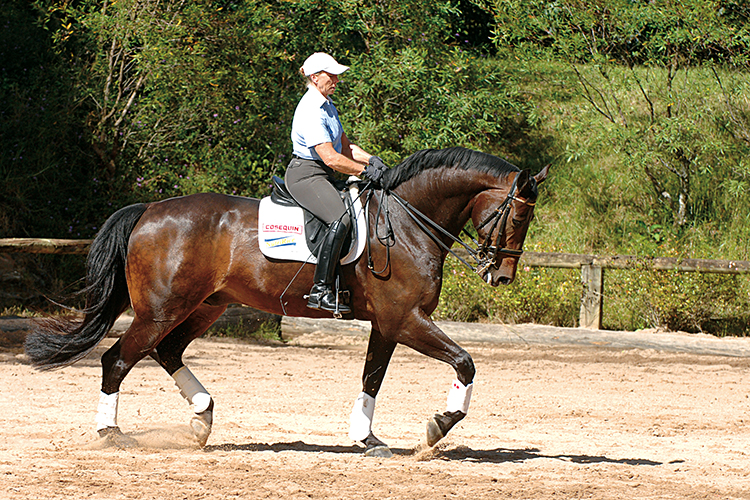
Stefan has spotted the slight irregularity of the rhythm, and suggests that it is because the horse is not really accepting the contact: “It’s good now, he’s not coming back and interrupting the rhythm when you touch him. School him so he can come to the hand.”
“Make sure that you do not start hesitating in passage. Work in the same manner as you do in walk or trot or canter, it’s just another movement. Think ‘trot’ in passage, think trot otherwise it gets very artificial. It is not just one boring passage, work the passage like you work the trot.”
“Don’t let him irritate you. Just keep doing the right aids, just keep going, there you go, now that is better. His body is involved, he is not tense, he is free with his body. Now piaffe. In piaffe, only the bit stays on the spot, the horse’s body keeps moving to it…”
Suddenly we have a beautiful sequence: passage / piaffe / passage…
“Good now get out of it and walk on a long rein.”
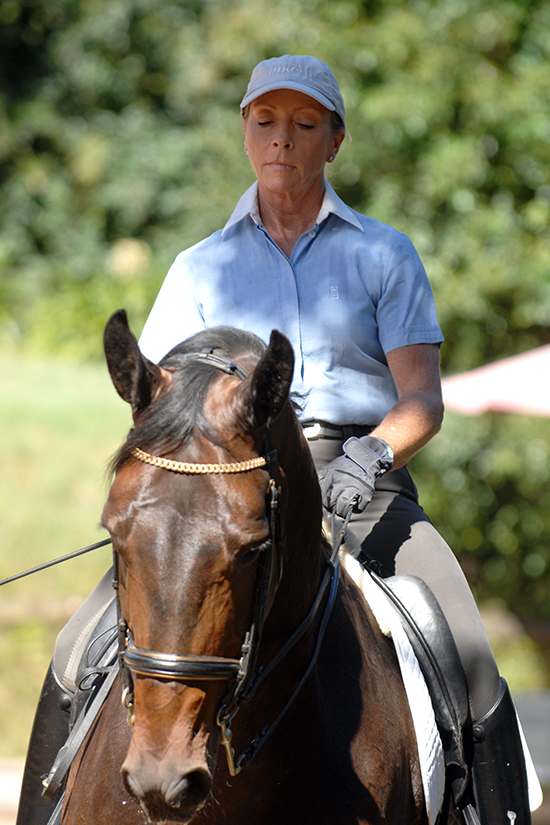
Later I discuss the lesson with Stefan…
With Judy it was a very interesting the problem that you were working on, when she started to try and use the reins, Frontier was ‘freezing’ and blocking and coming a little irregular, especially in the passage. What were you trying to get her to do to solve this problem?
“We see very often that the hand of the rider interrupts the movement of the horse – the hand influences the horse in a negative way. One of the most important things for the rider to work on, is to make sure movement is not affected by the hand. The rider always has to find a way to collect a horse, to work a horse, and you need your hand as an aid. The aim is to collect the horse, without getting less movement. So often when the rider goes to collect the horse, the movement gets less, it gets slower, or lazier, or even worse, the horse develops rhythm faults. The way must always be that the rider motivates the horse from behind and towards the bit, and then the rider can either give or restrain – so that the movement arrives in the hand and the horse can react, but it is not that the hand goes back towards the movement, it’s always the direction from behind, forward towards the hand.”
You were saying with Judy that when she went to passage she was losing the movement in her body that she has in the other paces…
“Horses react to riders more than we think. They feel when the rider gets stiff and hesitant up there. The horse’s body always follows the rider, and when the rider gets stiff that’s when the body of the horse also gets stiff and we end up in holding, pulling… Not that Judy is doing that, but it is a problem we should be aware of. You must keep working your horse relaxed, even in the higher movements.”
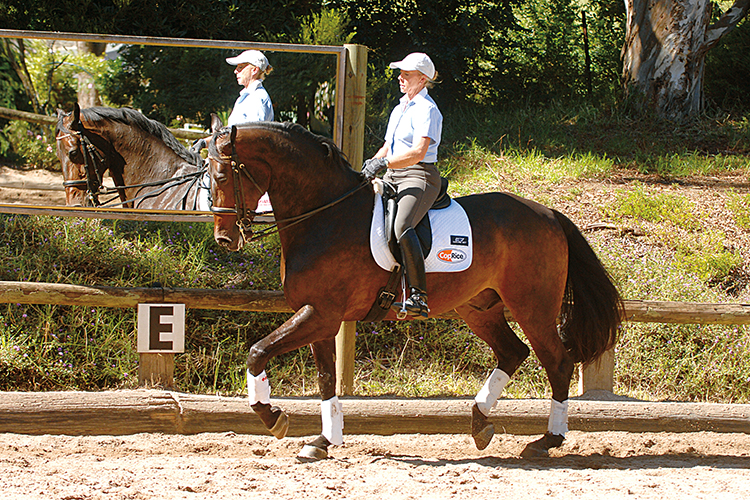
So the answer is to refresh – to go out of the collected movement?
“If you are in doubt, the answer is always, yes. If you get problems in the high collected movements, the safe way to fix the problem is in a working tempo. You can solve the problems there and then, if you have the horse supple and active again, then you can come back to the passage and then get the same work more-or-less that you get in the working trot.”
“When the horse gets crooked, especially in piaffe and passage, you often see irregular steps, especially in the hindlegs, which makes sense because one leg has to make a longer step than the other, so they get irregular. Often when a horse is irregular, the rider should check if it is really straight. A lot of times, all they need to do is straighten the horse, and then they get regular.”
You were working a lot trying to get the neck longer…
“The frame is always something that has to be taken care of very very well. A lot of horses are too tight, or not supple in the neck, which always has a bad influence on the natural balance of the horse, and further on the natural movement. The rider always has to take care that the frame is proper.”
You don’t use a lot of flexions to loosen the neck?
“I use flexions if necessary. Some horses for sure need to be worked in bend, but only for a short time. You can only bend a horse when it is working from behind towards the bit, then the hand can act. If the horse is not working properly from behind towards the hand, there is no reason to bend the horse – if you did that you would have to work backwards with your hand. The order is, the leg activates the horse, the horse swings towards the rein and then the hand can act – and not the other way. That was the problem here – I first wanted the horse to work more properly, more convincingly, towards the hand – then it is time to work. Then you can work more with your hand, but only when it is time.”
Do the legs have to keep asking all the time, or should you be able to put the horse forward and the horse keeps going forward?
“The leg, of course, stays in contact all the time to the horse’s body. It is best when the horse keeps working himself and you just have to keep the contact – but of course sometimes we have problems keeping the horse in front of the leg, then we have to keep reminding the horse and that is with our driving aid. Sometimes it can be less, and sometimes a bit more forward with your leg, to convince the horse and to motivate the horse to keep going. Every driving aid should have the result that after that driving aid, the horse is motivated to keep working on its own. The leg just keeps contact to control, and, if necessary, refresh the activity.”
And when you refresh with the leg, should you give with the hand?
“In general, yes. You can either release, or restrain. You have those two possibilities to ride into a releasing or restraining rein – but never into a rein that comes back.”
You said to Judy in the piaffe, that only the bit stayed on the spot that the horse must keep moving in the piaffe…
“First of all the horse has to have a forward tendency in piaffe, we all know that. Also the problem came up that the horse was getting more passive in the piaffe than in passage. We actually want, in a very nice piaffe, to have exactly the same independent activity that the horse shows in all the other movements. You see that all the time, horses start resisting in piaffe and working less, and getting behind the leg. I sometimes use expressions that I hope the riders can picture, just in order to tell the rider not to pull back, but in piaffe, keep working the horse towards the bit, and the bit restrains, and keeps the horse actually on the spot.”
Is that helped by the seat?
“Of course the seat gives a collecting aid too, but in a way that is not blocking the movement. The seat actually stays in the movement, it supports the movement, keeps it alive – the horse keeps constantly moving towards the bit so that we have the whole tendency from behind into the bit, kept. That’s hard in piaffe, the movement from behind into the bit, can get lost: it works the other way – from the front back towards the leg, and then the rider has to start pushing.”
When that happened, you didn’t grab a long whip and come behind Judy and Frontier and start banging around from the ground?
“I guess that is what we should all try, to train a horse without banging around with a whip. We all know riders who can train horses up to the highest movements, with a lot of expression, without a lot of pressure, and I think that is what every rider should try to do. If other riders can do it, then it is possible, and everyone should try to find a way to train a horse in an ethically nice way. I do work in hand, for sure, it depends on the sensitivity of the horse. You can support the higher collected work, with work in hand but still that work in hand does not mean that you are banging around. I think it is very important that the work in hand gets the horse lighter, and not more dependent on the whip. When you work in hand, the whip is the driving aid and as I said before, the driving aid should have the result that the horse works on its own.”
What are you trying to achieve with Judy and Frontier?
“We have here a horse and a rider, who have shown successfully at Grand Prix level, so at this stage, you have the chance to just work on the quality of the gaits and the quality of the suppleness. Both of them have reached a high level already, but there is always, with every horse and every rider, space left. Later that is what gets marked higher, the quality of the movement.”
With Frontier in the second working session, in the passage, it looked totally different from the first. In the first you were getting the interruptions of the rhythm but it became so much more even and rhythmic – what was the difference?
“Firstly place the horse was more supple. We had yesterday the problem that the horse was pulling up in the neck and hollowing the back a bit, and locking his muscles in the neck. In that situation a rider wants to ride forward and ask more from behind, or we end up very often with un-rhythmic steps. We worked a lot on that yesterday, also today in the beginning trot work and ended up with a horse being more supple in the neck and also a little lower and a more stretched contact. That right away ended up in a good result in the passage, in a rhythmic, active passage.”
It was interesting that you were saying you should ride different sorts of passage – treat it like a normal trot, it never occurred to me that there is more than one sort of passage?
“Well of course, you want to do the final passage with the most expression – and then, for the competition, you only have that very expressive passage. But it is usually very good to train the passage so that the horse sees the passage as a normal movement without too much tension, and without every time asking for the most expression, because after a while horses start to anticipate pressure and you get into trouble. If in the normal training, you sometimes work the horse in a more relaxed passage, and just work on the basics – you are also working on the trot – that helps you a lot for the transition to piaffe also.”
You were saying for piaffe, you need a gear up?
“Actually you just need to keep the same activity as you always have in the horse, but as the horse has to collect a lot more to carry more, most horses tend to get slower.”
The piaffe should be slightly faster because there is no moment of suspension?
“Right. In order to keep the horse active in the piaffe, slightly before the transition to piaffe, you have to activate the horse more in order to keep the same activity. The rhythm in piaffe is slightly faster, but that is just a natural result of the movement – I would never train a horse primarily to move faster in piaffe than passage, it is just a result of the movement.”
With Frontier now, is it just a matter of him getting more strength?
“Since I first saw the horse, he has matured a lot, he is now coming into the age where he can have the strength for a Grand Prix horse. Of course it is a question not only of strength, but also of progressively developing suppleness to work through the last issues in the training. You always have to keep working on that, you will always be finding weaknesses in the suppleness and submissiveness. For example, you will always have to work on straightness, you will always have to keep a horse fit, keep working on obedience, on the whole training scale. You will find you have to work through those steps in every training session.”
Stefan Wolff found another interesting horse to work with at his clinic at Clemens and Judy Dierks Training Stables. Linda Foster’s Mauritius is a rising star on the dressage scene. The gelding, by Medallion, out of a Donnerhall mare, has just moved into Prix St Georges ranks, and is scoring well. The rider, Linda Foster is also establishing herself in FEI ranks, with her third horse to make the grade.
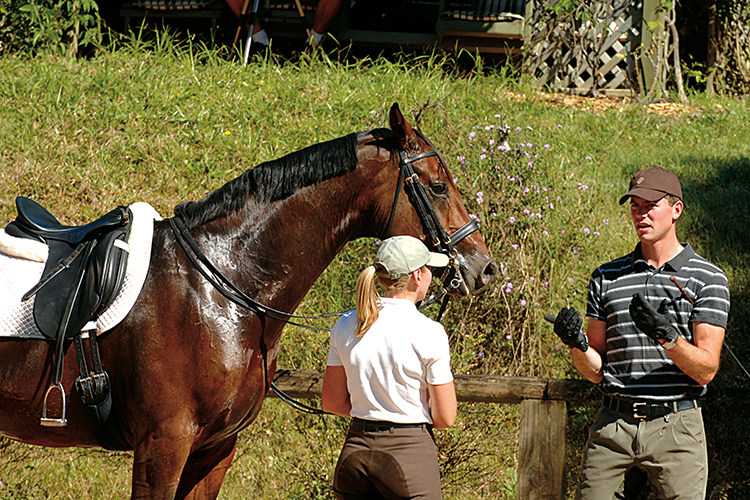
Linda has been riding dressage since she was a child:
“I rode from the age of 4, then had a fall and refused to get on anything with four legs until my parents organized lessons for me with Vicky Robertson. I was with Vicky from age nine to 24. It was always dressage. My ponies in Pony Club would buck me off when I tried to jump them, so I was always in the dressage arena, trying to get control. I guess I am a little bit of a perfectionist and dressage is my forte. When I was 25, I started working with Matthew Dowsley, then Clemens and Judy Dierks – with them, our progress has soared.”
“I went over to England when I was 19 – I worked for David Pincus for six months. I had a few offers to stay, but my mother came over to drag me back to finish university. I was intending to go back… and then I met my husband.”
“We have a family business that I work in part time, when things like EI crop up it’s something to fall back on. I do the accounts a couple of days a week, but other than that, it’s full-time with the horses. Mauritius is actually my third FEI horse. The first was Copperfield, a chestnut Thoroughbred, he got through to Prix St Georges, inter I, he could do the Grand Prix movements but it was a bit too much for him to put them all together. Then I had APH Socrates, he went through to Grand Prix until he was sold to Japan, and now Mauritius.”
Back in Clemens and Judy’s arena, it seems that connection remains the number one issue for our riders, and once again, Stefan is working to get the horse more through, more connected and yet again we discover how simple yet subtle this business of riding is:
“Be careful, the hindlegs get quicker but the impulsion is not going through the whole body. Get the hindlegs more connected to the front. You don’t have to worry about the activity, the activity is sufficient, it just has to connect to the body of the horse. Not just for two steps, there must be a constant connection, and make sure when you bring him back, you don’t lose the flow of the movement. You can only bring him back as much as you have him from behind. Don’t bring him back and slow the movement. Now bring him back but within the forward movement…”
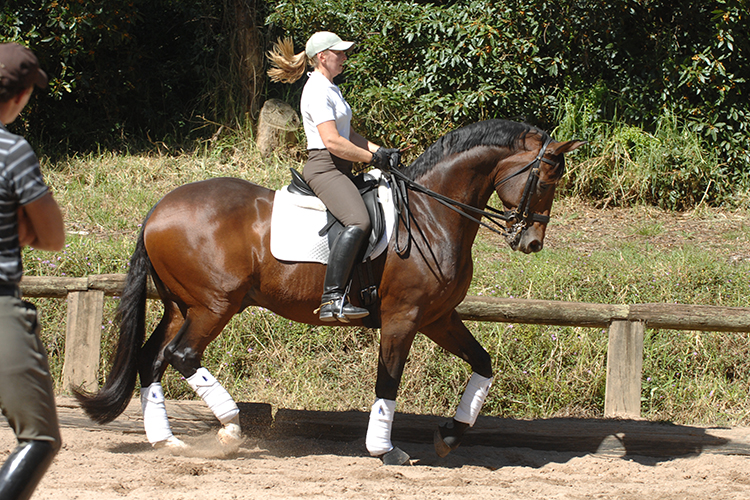
Now there’s another series of thoughts that could make your head spin if you thought about them too long…
“Think a little bit more forward when you collect. Keep riding, keep riding, get the collection in forward, collect him and go, collect him and go. Shorten the reins – light hands – and make him more active off the leg, you need a better acceptance of the leg. Don’t interrupt the movement when you collect him. Don’t get passive in your leg, you are shortening the stride too much in the collection. Be a little more demanding from behind – now light…”
And the strange environment was no excuse:
“Make sure you are not as defensive as your horse. Say ‘ok you are a little scared, but I am here to motivate you to go’. Collection does not mean less impulsion, just that you transfer this impulsion.”
And there was always a correct time for the correction:
“You start working when it is too late. You have to act and let him re-act. Be earlier than him.”
The next exercise was shoulder in:
“Not too much angle – and then you get better bend. Both your legs have to move the horse towards the bit, even though the horse goes sideways. In the half pass, the legs work primarily to the bit, not sideways. Within the sideways movement the horse needs to be connected with the reins… In the half pass, down the hand, and close your legs, both legs straight towards the bit.”
“Don’t attack with the driving aids. Worry more about a compact horse, use the leg to bring the back up. When would you bring him back? You can only bring him back when he is connected, otherwise you just hollow the back. Use your leg to make the whole thing more confident.”
“The driving that you are doing to get out of the half halt, is the driving you should be doing to get into the half halt. When you hesitate with your body and legs when you get in half halt, you lose everything. Don’t do more when you get out of the half halts than you do when you get into the half halts – rather the other way around.”
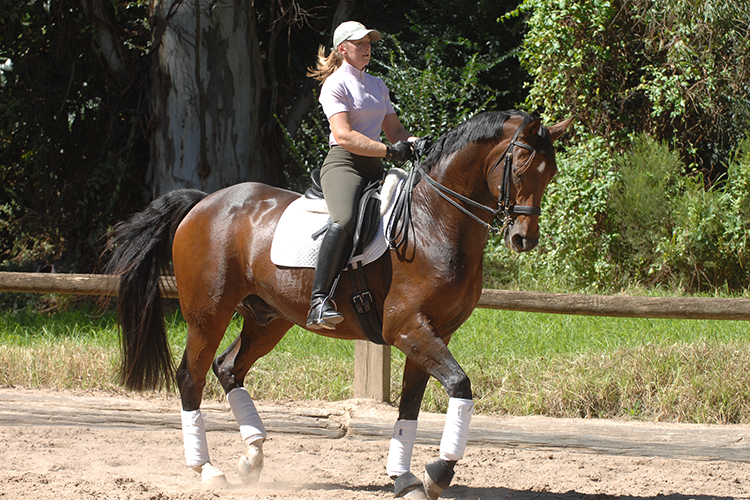
And all the time, Stefan wants the horses softer, more accepting of the aid:
“Soften the neck, the position is good but the suppleness is not there. Once he is in rhythm don’t chase him out, just let him carry you forward. And now in the extended trot – keep the collection.” (There’s another mindblower…)
Later I chatted with Stefan to get his take on the lesson with Linda and Mauritius:
“The horse has nice gaits, good ground covering quality. He has a little the tendency to come back, bring the neck up and hollow his back. So he comes easily behind the bit, which makes it pretty hard for the rider to keep constant impulsion in the horse. Especially when you come to the moment where she is about to collect the horse, the horse tends to come back and lose the impulsion. It’s a little bit hard to get him working from behind so you can convert impulsion into collection. It is important in that moment that Linda makes very sure that she keeps the impulsion from behind alive, or steady, when she brings the horse back into collection.”
You worked through that today?
“No we didn’t work through it. I think the first day is always there to open up problems and to start working on the major problems. Linda is here for at least three days, so we will continue to work on that. She got it – especially on the straight lines – she had a couple of nice moments. Of course in the half passes it is always harder to get the big rhythm, so we’ll keep working on that problem.”
You were trying to get a more even connection, even in the lateral work?
“Absolutely, the important thing in the lateral work is that you keep the basics correct, which means in the half passes we are not only thinking about driving the horse sideways – the sideways-moving horse must keep the straight work into the rein.”
If you are losing that, should you stop the lateral movement and go straight forward?
“You can try to refresh the impulsion and the straightness within the half pass, but if you don’t get a result – with this horse it is not so easy to get the impulsion back, then you can use a couple of forward steps on a straight line, then enter the half pass again, so you end up doing three strides half pass, three strides straight, constant change between straight steps and half pass steps, which can make it easier to get back the big rhythm.”
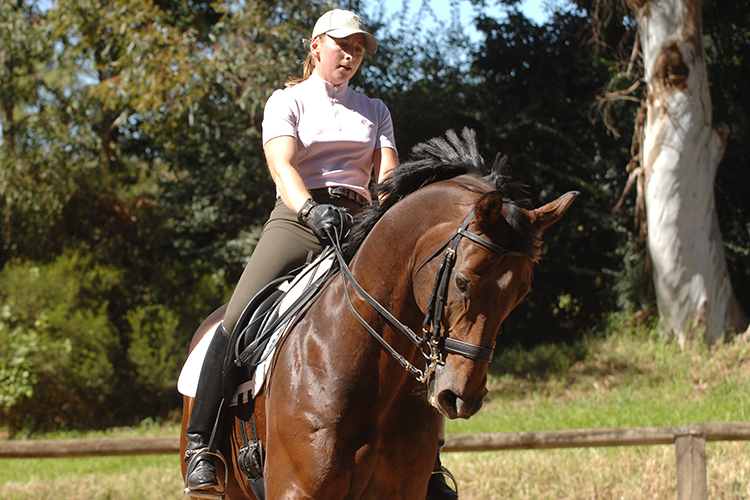
After the second day, Stefan was still focussed on connection:
“There we had the problem again of the connection. The horse has a little bit the tendency to hollow the back and therefore it is difficult – especially in the lateral work – to keep the big rhythm, because then it is harder for the horse to keep the back up and keep the rhythm. So we really did the same as yesterday – to have impulsion – but to make sure this impulsion is not disappearing somewhere but is connecting into the bit – so that there is the possibility to half halt the horse.”
It was interesting, Linda was doing extended trot and you were saying ‘keep the collection’…
“Extension is not chasing forward, in extension you keep a big part of collection in the horse. A proper extension depends on collection, so that the horse does not get out of balance. That’s the important thing that the horse stays in a total, proper balance and rhythm, and just lengthens the steps.”
The other concept is to separate your hands from your driving aids?
“That was especially for this rider because when she half halts she always slows the rhythm and the speed down. The hand in this case interferes with the natural movement and makes it slower, so we always have the problem that the horse does not swing in the half halt and keep the rhythm and have the higher cadence – it actually loses a bit of movement. So this was just a way that I tried to explain to Linda that the rein in the half halt is not to interfere with the movement – the movement should stay free and independent in the half halt, we are just asking for a higher level of collection.”
You were saying to Linda that the amount of forward you are giving at the end of the half halt, should be the amount of forward that you give going into the half halt…
“A clear half halt is ridden in such a way that the leg and the seat are driving the horse forward into a stronger contact and then the hand just restrains, and that is the aid that brings the horse in the higher collection. With Linda, what was missing was that the rider first drove the horse into a little more contact – and then the hand came back, so it was not possible to have a proper half halt – that’s why I was trying to get Linda to push the horse more into the half halt…”
And Linda was very happy with the progress of her horse…
“He’s a beautiful horse. He has a heart of gold. The sky’s the limit with him. I’ve had him since he was five. He was a colt, Matthew Dowsley had him at his stables, and I was desperately looking for a horse. I was tossing up between two and went for him – the ‘wow’ factor. He’s one of the most honest horses I’ve ever ridden.”
“He is doing Prix St Georges, and he’s done a couple of Inter I’s. Recently he’s been doing quite well at Prix St Georges – but he is training Grand Prix, he does all his ones. His speciality is piaffe, and the passage is getting stronger. We’re just waiting for the go-ahead from Clemens, to say ‘ok you can go out and do Grand Prix now’. But we are quite happy to potter around training and getting it closer to perfection.”
I find it interesting with horses that the things that are their beautiful and strong features can so easily become problems – when you look at his wonderful front, so lovely out of the shoulder and up, yet as Stefan was working with you, it was that beautiful neck that presented the problem because it can suck back so easily…
“It has always been something we’ve had to work on, right from the start. At the young horse competitions, we took him out and he got well over 90%, but on the 20 metre circle, that you had to do on the long rein, he just sat there, and I had this great loop of rein! It’s like he’s born to be on the bit, but it is a bit of a curse – it’s difficult in the training, but as Stefan says, it is difficult to train these ones, but in the long run they are the better ones. I just have to work it out, and get the connection right, and then it is amazing.”
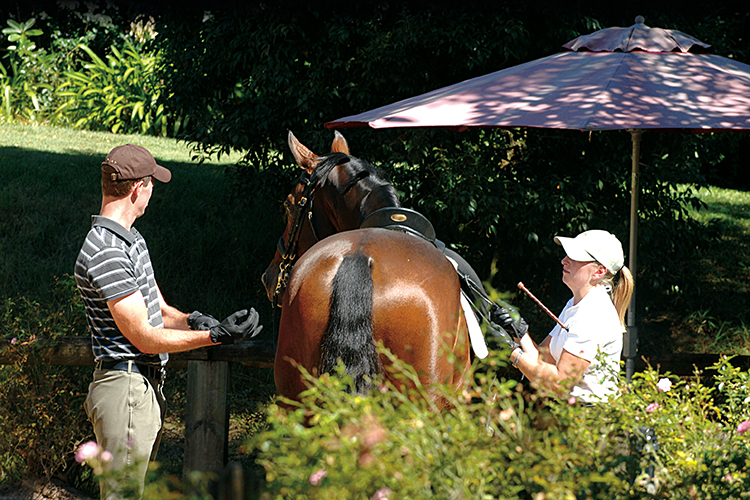
Stefan’s teaching about connection is very subtle, it is always flowing from one emphasis to the other?
“Absolutely. I think because it is so subtle, this horse has such good rhythm I think, I don’t want to disturb the rhythm – that’s in the Training Scale, always keep the rhythm – but in his case you have to disturb it a little bit to get the connection and to drive him out to the hand. It’s very subtle and difficult…”
We want him to go bigger and longer, but we don’t want him to go more forward…
“Exactly, when you are riding, Stefan is saying ‘make him go more forward’ – then he says ‘don’t let him run away, bring him back’ – then ‘not too far back’, and you are up there thinking ‘It’s terribly hard but I am going to get this.’ It haunts you, even when I’m driving home from a lesson, or going to sleep last thing, I’m thinking about that feeling, those moments you get when it is right, and try and reproduce that the next day. That’s what I love about dressage, it’s the intricacies of it, trying all the while to perfect it – and every horse is teaching you something. With this horse, it’s the connection that he is driving home to me.”
I think the other thing is that Stefan is so much a rider’s teacher – you know he spends hours in the saddle every day…
“He rides along with you and can see those moments even before I feel it! He can see I am starting to lose it, before I can feel it. Then I correct it, but it is a little bit late then, and that is the brilliance of Stefan. It’s like a jigsaw puzzle, he fixes this and this and this and this, and then it all comes together. WOW! Then you think… oh, how did I get this.”
That was an interesting concept, that in the half pass you had to be driving equally forward into both hands and that it was as much about driving forward as going sideways?
“And that is to do with the connection with this horse. He can do all the tricks, the tricks are not a problem but it’s the connection to keep the quality – rather than the horse just going sideways. Keep the connection to get the quality – that’s the hard bit.”
It’s true though, there is no point in going ahead with the movement once you’ve lost the quality…
“Exactly, we often think ‘oh the half pass is not right’ and we keep going sideways, keep going sideways, and you are actually practising the bad things. Better to go back and fix the connection, or the trot, or whatever, and then go back into the half pass.”
What are the areas you have to work on?
“The connection, that’s always been something we’re continually working at, and it always will be. When we get the connection right, the trot comes out of nowhere, and the passage is there, and he can piaffe. His canter is one of his specialities, it’s huge. He can also be a little bit spooky, just a little bit, just a little distracted. When the connection is there, and he’s on the aids, it all comes together.’
It was an interesting concept of pushing more into your half halt – I think Stefan said the push you are giving coming out of the half halt, should be the push you are giving going into the half halt…
“I think sometimes we all fall into it, when you half halt you are thinking a little bit backward, that’s the horse’s moment to slide out from underneath me rather than thinking forward and up and out to the connection. When I go out, if I over-push him, I just make him go long again. That’s something that will be revolving around in my mind, something to correct.”
“The half halt has to come from behind, doesn’t it?”
We say that, the activity must come from behind blah blah – but hanging it altogether and getting the result is still something special…
“Absolutely and the moments when he says – Jawohl – yesterday I wasn’t sure what that meant – I thought it might mean ‘more’ but it was ‘good don’t do any more’ – now I know and I think, Wow – now I’ve got it! Then I try to re-produce it, and I just miss it, but I can feel when I miss it now, and think, oh no, try again. It’s very exciting.”

Hello, I recently attended classes at the Westfalische Riete Schule under the direction of Mr Wolff, I have since returned to the USA and was wondering if you have an email address or other contact information to reach Mr Wolff.
Thanks in advance.
Kind Regards
Val